DataCard CP60 Plus User manual
- Category
- Plastic card printers
- Type
- User manual
This manual is also suitable for

Datacard
®
CP60™ and CP60 Plus
Card Printers
Service Manual
May 2007
Part No. 539358-002, Rev C

ii
Liability Statement
This product has been built to the high standards of Datacard Group. Please do
not attempt to operate or repair this equipment without adequate training. Any
use, operation, or repair in contravention of this document is at your own risk.
By acceptance of this system you hereby assume all liability consequent to your
use or misuse of this equipment. Datacard assumes no liability for incidental,
special, or consequential damage of any kind. Equipment specifications,
applications, and options are subject to change at the sole discretion of Datacard
without notice.
Proprietary Notice
All drawings and information herein are the property of DataCard Corporation.
All unauthorized use and reproduction is prohibited.
Trademark Acknowledgments
Datacard is a registered trademark and service mark of DataCard Corporation in
the United States and other countries. CP60 is a trademark of DataCard
Corporation.
All other product names are the property of their respective owners.
Datacard Group
11111 Bren Road West
Minnetonka, MN 55343-9015
952.933.1223
Fax: 952.933.7971
www.datacard.com
© 2006, 2007 DataCard Corporation. All rights reserved.
Printed in the United States of America.

iii
Contents
Chapter 1: Introduction __________________________________________________________ 1-1
Intended Audience_________________________________________________________________1-2
Avoiding Electrostatic Discharge ____________________________________________________1-2
Symbol Conventions________________________________________________________________1-3
Chapter 2: Theory of Operation___________________________________________________ 2-1
Printer Components ________________________________________________________________2-2
Functional Block Diagram _____________________________________________________2-2
Sensors_______________________________________________________________________2-3
Motors _______________________________________________________________________2-5
Miscellaneous ________________________________________________________________2-6
LCD Menu Diagram___________________________________________________________2-7
Sequence of Operation_____________________________________________________________2-8
Open Card Printer Differences______________________________________________________2-10
Graphics Printing __________________________________________________________________2-11
Printhead Settings _________________________________________________________________2-12
Magnetic Cards___________________________________________________________________2-14
Magnetic Data Principles_____________________________________________________2-14
Encoding Format ____________________________________________________________2-19
Magnetic Stripe Primary Data Standards ____________________________________________2-22
ISO/IEC 7811 (Parts 2 and 6) __________________________________________________2-22
AAMVA DL/ID-2000 __________________________________________________________2-22
Saflok and Ving______________________________________________________________2-22
Multiple Record Format (SDS)_________________________________________________2-23
JIS X 6302 (Type I and Type II Cards)___________________________________________2-23
Magnetic Media Locations___________________________________________________2-24
Data Track Locations_________________________________________________________2-25
Summary of Specifications____________________________________________________2-26
Character Encoding _________________________________________________________2-27
Smart Card Technology____________________________________________________________2-29
Contact Smart Cards ________________________________________________________2-30
Non-Contact Smart Cards____________________________________________________2-32
Chapter 3: Routine Maintenance _________________________________________________ 3-1
Required Tools and Supplies_________________________________________________________3-2
Routine Maintenance Procedure____________________________________________________3-3
Clean the Interior of the Printer ________________________________________________3-3
Mechanical Inspection________________________________________________________3-5
Run the Cleaning Card________________________________________________________3-8
Visual Inspection for Card Quality______________________________________________3-8
Chapter 4: Troubleshooting_______________________________________________________ 4-1
General Notes______________________________________________________________________4-2

iv
General Troubleshooting Procedures ________________________________________________4-2
Non-Clearing Repetitive Messages_____________________________________________4-2
Troubleshooting Sensors _______________________________________________________4-3
Troubleshooting Motors________________________________________________________4-4
Testing General DC Motors ______________________________________________4-4
Testing the Ribbon and Pick Motors_______________________________________4-5
Testing the Cam Motor __________________________________________________4-5
Testing the Printhead Fan________________________________________________4-6
Testing Transport and Duplex Motors______________________________________4-6
Troubleshooting Other Devices ________________________________________________4-6
Testing the Smart Card Solenoid__________________________________________4-6
Testing the Duplex Clutch________________________________________________4-7
Diagnosing the Duplex Interface Board___________________________________4-8
Diagnosing the Ribbon RFID Antenna_____________________________________4-8
Performance Problems______________________________________________________________4-9
Printer Initialization Errors_______________________________________________________4-9
Card Jams at Card Input_____________________________________________________4-10
Card Stalls at Output Stacker _________________________________________________4-10
Card Jams in Printing Area ___________________________________________________4-11
Ribbon Break Errors___________________________________________________________4-12
Error Codes _______________________________________________________________________4-13
Error Code Prefixes___________________________________________________________4-13
General Notes_______________________________________________________________4-13
Driver API (AP) _______________________________________________________________4-14
Printer Driver Errors (DR)_______________________________________________________4-14
Input Errors (IS) _______________________________________________________________4-17
Duplex Module Errors (DM) ___________________________________________________4-17
System Errors (SY) ____________________________________________________________4-18
Magnetic Stripe Errors (MS) ___________________________________________________4-19
Print Errors (PR)_______________________________________________________________4-24
Smart Card Errors (SC)________________________________________________________4-26
Chapter 5: Adjustments __________________________________________________________ 5-1
General Notes______________________________________________________________________5-3
Installing Printer Diagnostics _________________________________________________________5-3
Using Printer Diagnostics ____________________________________________________________5-5
Parts of the Diagnostics Window _______________________________________________5-5
Menu Options ________________________________________________________________5-6
Changing Printer Values_______________________________________________________5-8
Viewing and Saving Values ______________________________________________5-9
Working With Scripts ____________________________________________________5-10
Setting Printer Value Parameters ______________________________________________5-11
Printer ID_______________________________________________________________5-11
Card Registration Offset ________________________________________________5-11
Card Strip Offset _______________________________________________________5-12
Ribbon Type ___________________________________________________________5-12
Ribbon Offset __________________________________________________________5-12
Vertical Offset _________________________________________________________5-12
Transport Speed________________________________________________________5-13
YMC, K, T, & F Strobe Duty ______________________________________________5-13

v
YMC, K, T, and F Power and Base Power _________________________________5-14
Duplex Infeed Offset ___________________________________________________5-14
Duplex Home Offset____________________________________________________5-15
Duplex Print Return Offset_______________________________________________5-15
Duplex Handoff Offset__________________________________________________5-15
Smart Card Registration Offset __________________________________________5-15
Image Clipping Leading and Trailing ____________________________________5-16
Setting Printer Options________________________________________________________5-17
Viewing Printer Status ________________________________________________________5-18
Testing Motors _______________________________________________________________5-19
Testing Motor Functions ______________________________________________________5-20
Setting Up Step Tests for the Printer ____________________________________________5-21
Running a Magnetic Stripe Test Card__________________________________________5-22
Configuring the Magnetic Stripe Module ______________________________________5-23
Configuring Custom Track Formats____________________________________________5-25
Running Magnetic Stripe Diagnostics__________________________________________5-26
Testing the Smart Card Option________________________________________________5-27
Network Option Adjustments _______________________________________________________5-29
Software Adjustment Procedures ___________________________________________________5-33
Saving and Restoring a Printer Configuration __________________________________5-33
Start Sentinel Position_________________________________________________________5-35
Card Registration Offset Adjustment __________________________________________5-36
Ribbon Offset Adjustment ____________________________________________________5-37
Updating the Printer Firmware ________________________________________________5-38
Duplex Rotational Adjustment ________________________________________________5-39
Chapter 6: Removal and Replacement ___________________________________________ 6-1
General Notes______________________________________________________________________6-3
Symbols ______________________________________________________________________6-3
Required Tools________________________________________________________________6-3
Screw Torque Specifications ___________________________________________________6-3
Front Wire Routing ____________________________________________________________6-4
Duplex and Printhead Wire Routing ____________________________________________6-5
Functional Block Diagram _____________________________________________________6-6
Exterior Components________________________________________________________________6-7
Swingarm Cover______________________________________________________________6-7
Main Enclosure _______________________________________________________________6-8
Card Hopper _________________________________________________________________6-9
LCD Display _________________________________________________________________6-11
Swingarm Assembly________________________________________________________________6-13
Printhead Fan _______________________________________________________________6-14
Printhead Spring _____________________________________________________________6-15
Sensors____________________________________________________________________________6-16
Card Input Sensor (Without Clear Card) _______________________________________6-16
Card Input Sensor (With Clear Card) __________________________________________6-17
Swingarm Sensor_____________________________________________________________6-18
Ribbon Motion Sensor ________________________________________________________6-19
Ribbon Index Sensor _________________________________________________________6-20

vi
Cam Sensor _________________________________________________________________6-21
Card Hopper Empty Sensor___________________________________________________6-22
Motors ____________________________________________________________________________6-23
Transport Motor______________________________________________________________6-23
Pick Motor___________________________________________________________________6-24
Cam Motor__________________________________________________________________6-26
Ribbon Motor and Gear______________________________________________________6-27
Transport Assembly ________________________________________________________________6-29
Main Control Board __________________________________________________________6-32
Transport Timing Belt _________________________________________________________6-36
Belt Tensioner Pulley and Tension Spring _______________________________________6-37
Drive and Idler Pulleys________________________________________________________6-38
Cleaning Rocker Assembly ___________________________________________________6-39
Front Rocker Assembly _______________________________________________________6-40
Rear Rocker Assembly________________________________________________________6-41
Ribbon Guide _______________________________________________________________6-42
Pick Roller ___________________________________________________________________6-44
Cleaning Drive Roller_________________________________________________________6-46
Front Drive Roller_____________________________________________________________6-48
Rear Drive Roller _____________________________________________________________6-50
Platen Roller_________________________________________________________________6-53
Printhead Cam ______________________________________________________________6-54
Printhead Lifter ______________________________________________________________6-55
Front Card Guide ____________________________________________________________6-56
Rear Card Guide ____________________________________________________________6-57
Static Brushes________________________________________________________________6-59
RFID Antenna________________________________________________________________6-60
Duplex Module____________________________________________________________________6-61
Duplex Entry Sensor __________________________________________________________6-63
Duplex Home Sensor (Without Clear Card) ____________________________________6-65
Duplex Home Sensor (With Clear Card)________________________________________6-66
Duplex Interface Board_______________________________________________________6-67
Duplex Entry Rocker__________________________________________________________6-68
Duplex Motor________________________________________________________________6-69
Magnetic Clutch/Spring Clutch/Duplex Rollers_________________________________6-71
Magnetic Stripe Option ____________________________________________________________6-75
Magnetic Stripe Circuit Board_________________________________________________6-75
Magnetic Stripe Registration Sensor (Without Clear Card) ______________________6-76
Magnetic Stripe Registration Sensor (With Clear Card)__________________________6-77
Magnetic Stripe Head________________________________________________________6-78
Magnetic Stripe Rocker Assembly_____________________________________________6-80
Smart Card Option ________________________________________________________________6-81
Smart Card Interface Board __________________________________________________6-81
Solenoid Assembly/Solenoid Link______________________________________________6-82
Smart Card Contact _________________________________________________________6-84
Contactless Smart Card Coupler______________________________________________6-87

vii
Revision Log
Datacard CP60 and CP60 Plus Card Printers Service Manual
Revision Date Description of Changes
A March 2006 First release of this document.
B June 2006 Update part numbers for RoHS compliance.
C May 2007 Update for release of CP60 Plus printers.
Regulatory Compliance
Notice for USA (FCC Notice)
This equipment generates, uses, and can radiate radio frequency energy. If it is
not installed and used in accordance with this instruction manual, it may
interfere with radio communications. This equipment has been tested and found
to be within the limits for Class A computing devices, pursuant to Title 47 CFR
Part 15 Subpart B of FCC rules, designed to provide reasonable protection
against radio interference in a commercial environment. Operation of this
equipment in a residential environment may possibly cause interference. In the
event of interference, the user, at their own expense, will be required to take
whatever measures are necessary to correct the problem.
Notice for Canada
This digital apparatus does not exceed the Class A limits for radio noise for
digital apparatus set out in the Radio Interference Regulations of the Canadian
Department of Communications.
Le présent appareil numérique n'émet pas de bruits radioélectriques dépassant
les limites applicables aux appareils numériques de la classe A prescrites dans le
Règlement sur le brouillage radioélectrique édicté par le ministère des
Communications du Canada.

viii
Safety Issues
All Datacard products are built to strict safety and reliability specifications in
accordance with UL60950-1 and CUL requirements; therefore, safety issues
pertaining to operation and repair of Datacard equipment are primarily
environmental and human interface.
The following basic safety tips are given to ensure safe installation, operation,
and maintenance of Datacard equipment and are not to be considered as
comprehensive on all matters of safety.
Safe Environment
•
Connect equipment to a grounded facility power source. Do not defeat or
bypass the ground lead.
• Place the equipment on a stable surface (table), and ensure floors in work
area are dry and non-slip. Insulated rubber floor mats are preferred.
• Know the location of equipment branch circuit interrupters or circuit
breakers and how to turn them on and off in case of emergency.
• Know the location of fire extinguishers and how to use them. Use only ABC
type extinguishers on electrical fires.
• Know local procedures for first aid and emergency assistance at the customer
facility.
• Use adequate lighting at the equipment.
• Maintain the recommended range of temperature and humidity in
equipment area.
• Do not use this product in an environment containing volatile or flammable
compounds.
Safe Human Interface
• Use proper lifting techniques when moving or installing the equipment.
• Use standard electrostatic discharge (ESD) precautions when working on or
near electrical circuits.
• Do not defeat or disconnect safety interlocks.
• Observe standard safety precautions when servicing the system.
WARNING: To avoid a possible electric shock, always unplug the system
before servicing.

CP60 and CP60 Plus Service Manual 1-1
Chapter 1: Introduction
This chapter provides an introduction to the Datacard® CP60
and CP60 Plus card printers.
Intended Audience______________________________________________________________
1-2
Avoiding Electrostatic Discharge _________________________________________________ 1-2
Symbol Conventions_____________________________________________________________ 1-3

1-2 Introduction
Intended Audience
This manual is intended for use by authorized representatives of Datacard who
are responsible for the maintenance, service, and repair of the CP60 and CP60
Plus card printers. The service representatives must complete an authorized
Datacard service training course prior to servicing the printer.
Avoiding Electrostatic Discharge
While working around control boards and other sensitive components, use
proper equipment and procedures to reduce the possibility of damaging the
components. This section describes the procedure for protecting against damage
due to electrostatic discharge.
CAUTION: Static electricity can destroy components on a circuit board. Use
the following precautions when handling the board, its components, or tools
in contact with the board or its components.
Tools Required:
Static-grounding kit (Part Number: TUL006-006) containing:
• Static-grounding mat
• Mat-grounding cable
• Static-grounding wrist strap
• Wrist strap grounding cable
• Grounding plug
Procedure:
1. Wear appropriate clothing. Avoid wool and synthetic fabrics.
2. Remove movable carpet and rugs.
3. Apply the grounding strap to a wrist. Ensure that there is no clothing
between the strap and skin and that the strap is snug enough to maintain
contact with the skin.
4. Connect one end of the grounding cable to the wrist strap.
5. Using the grounding plug, connect the other end of the grounding cable to
the earth ground of a facility AC outlet.
6. Clear a work area, lay the static-grounding mat on the work area, and
connect the movable end of the long grounding cable to the mat.
7. Always set unshielded static-sensitive materials on the grounded anti-static
mat. Whenever possible, place components into static-shielded bags.
8. When bringing two objects into contact (tool to circuit board or board to mat),
first simultaneously touch both objects with fingers.

CP60 and CP60 Plus Service Manual 1-3
Symbol Conventions
The appearance and purpose of the symbols used in this manual are presented
below.
This symbol is used to designate a procedure that
involves electrostatic discharge sensitive components.
ESD procedures should be used.
CAUTION: This symbol indicates a strong cautionary
message to avoid serious damage to the printer.
WARNING: This symbol indicates a strong warning
message to prevent personal injury to the technician.
This symbol indicates a spring hazard. Safety glasses
should be worn when completing the procedure.
This symbol indicates a reminder message or other
additional information for the technician.
Graphic callouts with a colored background provide
incidental information about the graphic itself.
Graphic leaders with a colored background indicate a
direction of movement or similar information.

1-4 Introduction

CP60 and CP60 Plus Service Manual 2-1
Chapter 2: Theory of Operation
This chapter provides the theory of operation for the CP60 and CP60
Plus card printers.
Printer Components______________________________________________________________ 2-2
Functional Block Diagram _____________________________________________________________2-2
Sensors_______________________________________________________________________________2-3
Motors _______________________________________________________________________________2-5
Miscellaneous ________________________________________________________________________2-6
LCD Menu Diagram___________________________________________________________________2-7
Sequence of Operation__________________________________________________________ 2-8
Open Card Printer Differences___________________________________________________ 2-10
Graphics Printing _______________________________________________________________ 2-11
Printhead Settings ______________________________________________________________ 2-12
Magnetic Cards ________________________________________________________________ 2-14
Magnetic Data Principles ____________________________________________________________2-14
Encoding Format ____________________________________________________________________2-19
Magnetic Stripe Primary Data Standards _________________________________________ 2-22
ISO/IEC 7811 (Parts 2 and 6) __________________________________________________________2-22
AAMVA DL/ID-2000 __________________________________________________________________2-22
Saflok and Ving______________________________________________________________________2-22
Multiple Record Format (SDS)_________________________________________________________2-23
JIS X 6302 (Type I and Type II Cards)___________________________________________________2-23
Magnetic Media Locations___________________________________________________________2-24
Data Track Locations ________________________________________________________________2-25
Summary of Specifications ___________________________________________________________2-26
Character Encoding _________________________________________________________________2-27
Smart Card Technology_________________________________________________________ 2-29
Contact Smart Cards ________________________________________________________________2-30
Non-Contact Smart Cards____________________________________________________________2-32

2-2 Theory of Operation
Printer Components
Functional Block Diagram

CP60 and CP60 Plus Service Manual 2-3
Sensors
All of the optical sensors in the CP60 and CP60 Plus printers are of the open
collector type, and are configured to be active-low with a pull-up resistor on the
output. When the sensor is not active (or not connected at all) the control board
sees a high voltage (5V) at the Signal input. When the sensor is active, it shorts
Signal to Ground. The diagram below is a simplified representation of an
interruption sensor.
Name Function
Card Input
The card input sensor is an interruption sensor that detects the presence
of a card at the entry of the printer and registers the trailing edge of the
card for printing.
For the clear card option, this sensor is replaced with a reflective sensor.
Printhead Cam
As the printhead cam rotates, a flag on the cam interrupts the beam of
the cam sensor. This allows the printer to know the position of the
printhead lifters. The printhead lifters lift the printhead away from the
platen roller when not printing.
Swingarm Open
(Cover arm)
The swingarm open sensor detects when the swingarm is open. The sensor
itself detects when the swingarm is closed, but the signal is inverted
elsewhere in the system.
Note: The user information and Diagnostics refer to this as a cover arm
sensor.
Ribbon Index
The ribbon index sensor is used to determine the position of the print
ribbon panels. The sensor bounces a beam off the reflective sticker on the
printhead. When the index mark or K-panel on the ribbon passes between
the sensor and the reflector, the beam is broken (not reflected). The Y, M,
C, & T panels do not interrupt the beam.
Ribbon Motion
The ribbon motion sensor is a two-channel optical interruption sensor that
detects slots on the ribbon encoder wheel. The encoder wheel is located
on the ribbon cartridge. Internally the sensor body contains a pair of
standard interruption sensors.

2-4 Theory of Operation
Name Function
Magnetic Stripe
Registration
This is a reflective sensor that locates the leading edge of the card for
magnetic stripe encoding. When no card is present, the sensor beam
reflects off a plate on the magnetic stripe rocker. When a card passes
between the sensor and the reflector, the beam is broken (not reflected).
The sensor itself is active when no card is present, but the signal is inverted
elsewhere in the system.
For the clear card option, this sensor is replaced with another reflective
sensor.
Magnetic Stripe
Optical Encoder
This encoder monitors the rotation of the idler roller in the magnetic stripe
module. It provides positional feedback to the module to ensure proper
magnetic encoding.
Duplex Entry
The duplex entry sensor is an optical interruption sensor that detects the
presence of a card as it enters and leaves the duplex module.
For the clear card option, this sensor is replaced with a reflective sensor.
Duplex Home
The duplex home sensor determines the rotational position of the duplex
flipper. The flipper has three flags that pass through the sensor.
Input Hopper
Empty (Optional)
This reflective sensor detects when the card hopper has no cards left. It
functions only when special software is created to use it.

CP60 and CP60 Plus Service Manual 2-5
Motors
The CP60 and CP60 Plus printers have up to five motors depending on the
configuration. The three DC motors are all similar, with an integral reduction
geartrain and 24-volt operation. The speed of the motors is controlled by pulse
width modulation. While the motors are reversible, some are wired to operate in
one direction only. The duplex step motor operates at 24 volts, but the transport
step motor operates at 40 volts.
Name Function
Pick Motor
The pick motor drives the pick roller to bring a card into the system. The
motor is wired for unidirectional operation and cannot be reversed by
the control board. One wire is tied to ground and the other wire is the
control. This motor is driven by a single channel in the motor driver.
Transport Motor
The transport motor drives the platen roller through a gear, which also
drives the main transport belt. This is a 2-phase (4-wire), 40-volt stepper
motor.
Cam Motor
The cam motor rotates the printhead cam, which operates the
printhead lifters. This raises and lowers the printhead into position for
printing or permitting a card to pass beneath. This motor is wired bi-
directional and uses two channels from the motor controller so that it
can be reversed. (However at this time, the motor is not operated in
reverse.)
Ribbon Motor
The ribbon motor drives the gear train of the ribbon cartridge to
advance the ribbon during printing. The motor is wired for
unidirectional operation and cannot be reversed by the control board.
One wire is tied to ground and the other wire is the control. This motor is
driven by a single channel in the motor driver.
Duplex Motor
The duplex motor drives a gear on the duplex clutch. The clutch
permits a single motor to either operate the rollers, or rotate the entire
flipper assembly (this is discussed in more detail on page
2-6). This is a
2-phase (4-wire), 24-volt stepper motor.

2-6 Theory of Operation
Miscellaneous
Name Function
Smart Card Solenoid
The smart card solenoid retracts the smart card rocker downward
so the contacts touch the card. When relaxed, a return spring lifts
the rocker and contacts away from the card.
Duplex Clutch
The duplex clutch controls whether the duplex motor operates the
drive rollers or rotates the whole flipper assembly. The clutch
contains two concentric axes that are free to rotate
independently when the clutch is relaxed. When the clutch is
active, a magnetic field pulls the two axes together and friction
forces the two to rotate in unison. Because the clutch is engaged
magnetically, the rotation of either axis is independent from the
body of the clutch.
Operation: The duplex motor rotates the outer axis (large gear),
which is coupled to the two duplex drive rollers. The flipper
assembly is coupled to the inner axis. When the clutch is relaxed,
the outer axis (gear) rotates independently from the flipper
assembly, and this causes the drive rollers to rotate. When the
clutch is engaged, the whole flipper assembly rotates in unison
with the large gear, which keeps the drive rollers from rotating.
RFID Antenna
The RFID antenna circuit board is a simple loop antenna that
communicates with the supplies ID chip in the ribbon supply spool.
The bi-directional communication method is similar to
Non-
Contact Smart Cards (p. 2-32) using load-modulation, although
the specific details may vary.
Duplex Interface
Board
The duplex interface board contains a step motor driver for the
duplex motor, and a 24-volt driver circuit for the clutch. The sensor
signals are passed through directly from the main control board.
Magnetic Stripe
Daughter Board
There are two types of magnetic stripe daughter boards: 3-track
and single track. The circuit board controls the magnetic stripe
head and provides an interface for the optical encoder. The
optical encoder data is passed back to the main control board
without modification.
Smart Card Daughter
Board
The smart card daughter board provides a communication
interface between the application computer and the smart card.
Most of the communication aspects and the data transfer are
controlled by an external software application, and are
transparent to the printer. The daughter board also provides a
connection to control the smart card solenoid.

CP60 and CP60 Plus Service Manual 2-7
LCD Menu Diagram

2-8 Theory of Operation
Sequence of Operation
Power-on Initialization
1. When the printer is plugged in, it begins its initialization routine. (There is no
On/Off switch.)
2. As the main control board initializes itself, the status light on the front of the
printer will be steady amber.
3. After the control board is initialized, the status indicator will cycle through
Red, Amber, and Green.
4. While the control board examines and initializes external components, the
indicator will flash green.
A. It checks for smart card, magnetic stripe, and duplex modules.
B. The duplex module is initialized, and the rollers are operated for
sufficient time to ensure no cards are present in the module.
C. The printhead cam motor is cycled and homed.
D. The transport is initialized and then operated for sufficient time to ensure
that the card track is clear.
E. The ribbon type is identified. This may or may not result in the ribbon
motor being energized for a short time to detect a ribbon encoder change.
5. When the printer has finished its initialization procedure and is ready to
process cards, the status light will turn green.
Default Card Production Sequence
1. After the card data has been sent to the printer, it begins the card
personalization process.
2. The card is picked and passes through the cleaning rollers.
3. After the leading edge of the card passes through the cleaning rollers, the
card is detected by the input sensor. The trailing edge of the card is registered
for positioning.
4. The card is first sent to the smart card area.
A. When the card is approaching the location of the smart card contacts, the
solenoid engages and pulls the contacts down.
B. The leading edge of the card makes contact with the smart card sensor
(mechanical switch in the contact block) and the transport stops.
C. The card is programmed by an external application. The printer acts only
as an interface to the card.
D. The external application notifies the printer that smart card interaction is
complete, and control is returned to the printer.
Page is loading ...
Page is loading ...
Page is loading ...
Page is loading ...
Page is loading ...
Page is loading ...
Page is loading ...
Page is loading ...
Page is loading ...
Page is loading ...
Page is loading ...
Page is loading ...
Page is loading ...
Page is loading ...
Page is loading ...
Page is loading ...
Page is loading ...
Page is loading ...
Page is loading ...
Page is loading ...
Page is loading ...
Page is loading ...
Page is loading ...
Page is loading ...
Page is loading ...
Page is loading ...
Page is loading ...
Page is loading ...
Page is loading ...
Page is loading ...
Page is loading ...
Page is loading ...
Page is loading ...
Page is loading ...
Page is loading ...
Page is loading ...
Page is loading ...
Page is loading ...
Page is loading ...
Page is loading ...
Page is loading ...
Page is loading ...
Page is loading ...
Page is loading ...
Page is loading ...
Page is loading ...
Page is loading ...
Page is loading ...
Page is loading ...
Page is loading ...
Page is loading ...
Page is loading ...
Page is loading ...
Page is loading ...
Page is loading ...
Page is loading ...
Page is loading ...
Page is loading ...
Page is loading ...
Page is loading ...
Page is loading ...
Page is loading ...
Page is loading ...
Page is loading ...
Page is loading ...
Page is loading ...
Page is loading ...
Page is loading ...
Page is loading ...
Page is loading ...
Page is loading ...
Page is loading ...
Page is loading ...
Page is loading ...
Page is loading ...
Page is loading ...
Page is loading ...
Page is loading ...
Page is loading ...
Page is loading ...
Page is loading ...
Page is loading ...
Page is loading ...
Page is loading ...
Page is loading ...
Page is loading ...
Page is loading ...
Page is loading ...
Page is loading ...
Page is loading ...
Page is loading ...
Page is loading ...
Page is loading ...
Page is loading ...
Page is loading ...
Page is loading ...
Page is loading ...
Page is loading ...
Page is loading ...
Page is loading ...
Page is loading ...
Page is loading ...
Page is loading ...
Page is loading ...
Page is loading ...
Page is loading ...
Page is loading ...
Page is loading ...
Page is loading ...
Page is loading ...
Page is loading ...
Page is loading ...
Page is loading ...
Page is loading ...
Page is loading ...
Page is loading ...
Page is loading ...
Page is loading ...
Page is loading ...
Page is loading ...
Page is loading ...
Page is loading ...
Page is loading ...
Page is loading ...
Page is loading ...
Page is loading ...
Page is loading ...
Page is loading ...
Page is loading ...
Page is loading ...
Page is loading ...
Page is loading ...
Page is loading ...
Page is loading ...
Page is loading ...
Page is loading ...
Page is loading ...
Page is loading ...
Page is loading ...
Page is loading ...
Page is loading ...
Page is loading ...
Page is loading ...
Page is loading ...
Page is loading ...
Page is loading ...
Page is loading ...
Page is loading ...
Page is loading ...
Page is loading ...
Page is loading ...
Page is loading ...
Page is loading ...
Page is loading ...
Page is loading ...
Page is loading ...
Page is loading ...
Page is loading ...
Page is loading ...
Page is loading ...
Page is loading ...
Page is loading ...
Page is loading ...
Page is loading ...
Page is loading ...
Page is loading ...
Page is loading ...
Page is loading ...
Page is loading ...
Page is loading ...
Page is loading ...
Page is loading ...
Page is loading ...
Page is loading ...
Page is loading ...
Page is loading ...
Page is loading ...
Page is loading ...
Page is loading ...
Page is loading ...
Page is loading ...
Page is loading ...
Page is loading ...
Page is loading ...
Page is loading ...
Page is loading ...
Page is loading ...
Page is loading ...
Page is loading ...
Page is loading ...
Page is loading ...
Page is loading ...
-
 1
1
-
 2
2
-
 3
3
-
 4
4
-
 5
5
-
 6
6
-
 7
7
-
 8
8
-
 9
9
-
 10
10
-
 11
11
-
 12
12
-
 13
13
-
 14
14
-
 15
15
-
 16
16
-
 17
17
-
 18
18
-
 19
19
-
 20
20
-
 21
21
-
 22
22
-
 23
23
-
 24
24
-
 25
25
-
 26
26
-
 27
27
-
 28
28
-
 29
29
-
 30
30
-
 31
31
-
 32
32
-
 33
33
-
 34
34
-
 35
35
-
 36
36
-
 37
37
-
 38
38
-
 39
39
-
 40
40
-
 41
41
-
 42
42
-
 43
43
-
 44
44
-
 45
45
-
 46
46
-
 47
47
-
 48
48
-
 49
49
-
 50
50
-
 51
51
-
 52
52
-
 53
53
-
 54
54
-
 55
55
-
 56
56
-
 57
57
-
 58
58
-
 59
59
-
 60
60
-
 61
61
-
 62
62
-
 63
63
-
 64
64
-
 65
65
-
 66
66
-
 67
67
-
 68
68
-
 69
69
-
 70
70
-
 71
71
-
 72
72
-
 73
73
-
 74
74
-
 75
75
-
 76
76
-
 77
77
-
 78
78
-
 79
79
-
 80
80
-
 81
81
-
 82
82
-
 83
83
-
 84
84
-
 85
85
-
 86
86
-
 87
87
-
 88
88
-
 89
89
-
 90
90
-
 91
91
-
 92
92
-
 93
93
-
 94
94
-
 95
95
-
 96
96
-
 97
97
-
 98
98
-
 99
99
-
 100
100
-
 101
101
-
 102
102
-
 103
103
-
 104
104
-
 105
105
-
 106
106
-
 107
107
-
 108
108
-
 109
109
-
 110
110
-
 111
111
-
 112
112
-
 113
113
-
 114
114
-
 115
115
-
 116
116
-
 117
117
-
 118
118
-
 119
119
-
 120
120
-
 121
121
-
 122
122
-
 123
123
-
 124
124
-
 125
125
-
 126
126
-
 127
127
-
 128
128
-
 129
129
-
 130
130
-
 131
131
-
 132
132
-
 133
133
-
 134
134
-
 135
135
-
 136
136
-
 137
137
-
 138
138
-
 139
139
-
 140
140
-
 141
141
-
 142
142
-
 143
143
-
 144
144
-
 145
145
-
 146
146
-
 147
147
-
 148
148
-
 149
149
-
 150
150
-
 151
151
-
 152
152
-
 153
153
-
 154
154
-
 155
155
-
 156
156
-
 157
157
-
 158
158
-
 159
159
-
 160
160
-
 161
161
-
 162
162
-
 163
163
-
 164
164
-
 165
165
-
 166
166
-
 167
167
-
 168
168
-
 169
169
-
 170
170
-
 171
171
-
 172
172
-
 173
173
-
 174
174
-
 175
175
-
 176
176
-
 177
177
-
 178
178
-
 179
179
-
 180
180
-
 181
181
-
 182
182
-
 183
183
-
 184
184
-
 185
185
-
 186
186
-
 187
187
-
 188
188
-
 189
189
-
 190
190
-
 191
191
-
 192
192
-
 193
193
-
 194
194
-
 195
195
-
 196
196
-
 197
197
-
 198
198
-
 199
199
-
 200
200
-
 201
201
-
 202
202
-
 203
203
-
 204
204
-
 205
205
-
 206
206
-
 207
207
-
 208
208
-
 209
209
-
 210
210
-
 211
211
-
 212
212
DataCard CP60 Plus User manual
- Category
- Plastic card printers
- Type
- User manual
- This manual is also suitable for
Ask a question and I''ll find the answer in the document
Finding information in a document is now easier with AI
Related papers
-
DataCard SP75 Plus User manual
-
DataCard SD460 User manual
-
DataCard CD820 User Reference Manual
-
DataCard CD820 User Reference Manual
-
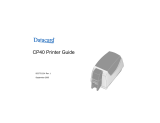 Datacard Group CP40 User manual
Datacard Group CP40 User manual
-
DataCard CR500 User Reference Manual
-
DataCard CR500 User Reference Manual
-
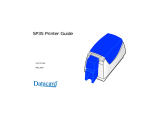 Datacard Group SP35 User manual
Datacard Group SP35 User manual
-
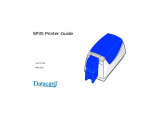 Datacard Group Printer 553772-001 User manual
Datacard Group Printer 553772-001 User manual
-
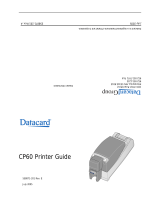 Datacard Group CP60 User manual
Datacard Group CP60 User manual
Other documents
-
Acroprint ESP180 Quick start guide
-
Polaroid P3500S User manual
-
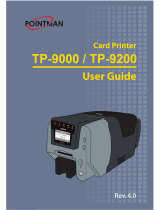 Pointman TP-9000 User manual
Pointman TP-9000 User manual
-
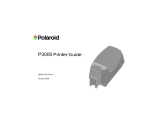 Ribbon print P3000 User manual
Ribbon print P3000 User manual
-
Polaroid P4000 User manual
-
Toro Sentinel Software Owner's manual
-
Magtek ExpressCard 1000 Quick Installation Guide
-
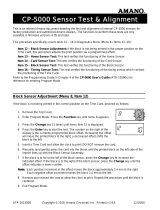 Amano CP-5000 Quick start guide
Amano CP-5000 Quick start guide
-
Magtek ExpressCard 1000 Owner's manual
-
Zebra ZXP Series 7 Troubleshooting Manual


























































































































































































































